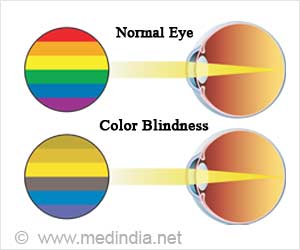Everything you need to know about color blindness in under 2 minutes (with great pictures).
Color blindness is the deficiency to see color or distinguish a difference in shades of color. Normally, human eyes can recognize millions of colors; having different color receptors for red, green and blue. But according to information from NIH, 8% of men and 0.5% of women are affected by color blindness.
Colors are essential for distinguishing things and recognizing information. With so many colors available, it is surprising to know that some people can’t distinguish between different shades of color.
What is color blindness?
Color blindness (or color vision deficiency, CVD) is a common condition that, unlike complete loss of sight or hearing, is relatively subtle for those around the person with the condition and therefore largely neglected. Color blindness affects more than 4% of men and 0.5% of women in the United States. Most people with CVD are completely unaware they have the condition themselves.

How do we see color?
The human eye and brain work to turn light into color. You can see color because light receptors within the eye transmit messages to your brain.
Scientist in the 1700's thought that color was not a distinct feature of objects. While we see different colors, in fact, the surfaces of objects reflect only some colors and absorb all the others.
We perceive only the reflected colors. In more detail: about 2/3 of the cones process the longer light wavelengths (reds, oranges, and yellows) and about 1/3 process the shorter ones (violet, blue).
Studies show that about 8% of males and 1% of females have some form of color blindness. Although most nuances of color differentiate people from their surroundings, most people with color vision impairments can still perceive color. In rare cases, individuals with severe red-green color vision errors are unable to distinguish certain colors.

Is color blindness genetic?
Color blindness is a genetic condition that affects millions of people. It is passed on to children by their parents, who may or may not be color blind themselves.
Color blindness results from a deficiency in an individual's cone cells. These cells are responsible for color vision and are located in the retina at the back of the eye. There are three types of cones: red, green and blue. Each cell contains pigments that absorb light. The brain is then able to distinguish between different colors based upon the different wavelengths of light absorbed by these pigments.
A person with normal color vision can see about one million colors. In contrast, a person with color blindness has a limited ability to see colors because their cone cells do not contain enough pigment, or because they do not work correctly.
The most common form of color blindness is red-green color blindness. A person with this type of deficiency will confuse between red and green colors, but will still be able to see yellow and blue colors clearly.
Related article: What the H*ck is Astigmatism?
Common Risk factors
Color blindness is an anomaly. A person with color blindness does not see colors as most people do. The colors appear dull and different than to a person with normal vision. Color cognition can be divided into two groups: the first group, called dichromats, cannot distinguish red and green. The second group, called anomalous trichromats, have difficulty distinguishing red and green or blue and yellow. Men are much more commonly affected than women; about 8% of men are color blind but only 0.5% of women have this condition.
Color blindness is usually inherited and rarely caused by injury to the eye or optic nerve or the brain. This condition may also be caused by a disease or a side effect from taking certain drugs or chemicals such as pesticides. Those with color blindness are unable to distinguish between certain colors, although they can see shades of gray and other colors normally. In most cases, those who are color blind can perform everyday tasks as well as others.
Types of color blindness include:
Red-green color blindness (most common) - unable to distinguish between red and green
Blue-yellow color blindness - unable to distinguish between blue and yellow
Total color blindness (very rare) - inability to tell between any colors; most often due to damage
Color Blindness Diagnosis
Your optometrist should be able to determine if you are color blind with some simple test.
This test is designed to evaluate your ability to see color. It will show you one picture made up of colored dots and a picture that is the same but with many of the colors removed. You will be asked to tell the test administrator if you see any number or shape among the dots of the first picture. If you cannot see any number or shape in the dots, you may continue with the other parts of the test.

Color Blindness Treatment
While there is currently no available cure for genetic color blindness, many non-prescription and prescription products exist that may help color blindness.
If your color blindness is caused by non-genetic reasons your eye doctor will be able to help you get the treatment you need.
Conclusion
We hope that this was a helpful guide to what you can do if you are color blind, or if you know someone who is. Even if you aren't color blind, it's important that you understand more about the topic so that you can support any friends or family members who are. And if you're worried that you might be color blind, don't let fear keep you from making an appointment with an eye doctor. If a cure exists for your type of color blindness, there's nothing to lose by finding out!
